Introduction to the Hebrew Alphabet
The Hebrew Alphabet, which is also called Alefbet (combination of the first two letters of the Hebrew alphabet) is made of 22 letters.
This page will teach you the basics of the Hebrew writing system. To learn to write the letters and memorise them, we suggest using our Hebrew Alefbet app.
Of, the 22 letters, 5 of then will change shape a little when the letter is used at the end of a word. Some of the letters can also be modified with a dagesh (small dot), which will change its pronounciation.
Hebrew is written right to left.
Hebrew can be written in either Print/Block form, or the hand written cursive form. The print form is the form you will come across most often in reading Hebrew texts and that which the beginner should familiarise them selves with first.
The letters of the alefbet are:
| Sound | |||
| 1 | Alef | א | - |
| 2 | Bet | בּ | b/v |
| 3 | Gimel | ג | g |
| 4 | Dalet | ד | d |
| 5 | He | ה | h |
| 6 | Vav | ו | v |
| 7 | Zayin | ז | z |
| 8 | Het/Chet | ח | h/ch |
| 9 | Tet | ט | t |
| 10 | Yod | י | y |
| 11 | Kaf | כ | k/kh/ch |
| 12 | Lamed | ל | l |
| 13 | Mem | מ | m |
| 14 | Nun | נ | n |
| 15 | Samekh | ס | s |
| 16 | Ayin | ע | - |
| 17 | Pe | ע | p/f |
| 18 | Tsadi | צ | ts |
| 19 | Qof | ק | q |
| 20 | Resh | ר | r |
| 21 | Shin | ש | sh/s |
| 22 | Tav | ת | t |
The sounds are the approximate sound equivalents in English. The name of each letter starts with the sound of the letter it represents. Note, the Het/Chet has no equivalent in English. Resh also differs from the 'r' in English. Alef and Ayin are usually silent or take the accompanying vowel sound.
The Alef-bet does not contain vowels. How the consonants are modified by vowel sounds can be unclear unless you are fluent in Hebrew. To make it easier
to pronounce, a system of dots/markings above, beside or below the characters is used. This system is known as niqqud.
Shin
Shin can represent both the 's' an 'sh' sounds in English. It has two forms, one with a dot on the left for the 's' sound, and one with the dot on the right for the 'sh' sound. These dots are called the sin and shin dots respectively.
| Name | Dot Position | Symbol | Sound |
|---|---|---|---|
| Sin | Left | שׂ | s |
| Shin | Right | שׁ | sh |
Bet & Vet
Bet, being the second letter in the alef-bet, is normally the first letter that is learnt with a dagesh and pronunciation change. Bet can be written with or without a dot in the center. This dot is known as a dagesh, and indicates a pronunciation change. For this letter, the dot tells us it is pronounced with a 'b' sound. If there is no dot, it should be pronounced with a 'v' sound.
| Name | Symbol | Sound |
|---|---|---|
| Bet | בּ | b |
| Vet | ב | v |
Dagesh is often omitted in writing such that both bet and vet can be written as ב.
More Dagesh
In addition to bet/vet dagesh, we also see dageshes used with the kaf(כ) and pe(פ) letters. These letters also change shape when they are the final letter in a word, but only Kaf is used with a dagesh in its final form.| Letter | Symbol | Symbol As Final | Sound |
|---|---|---|---|
| Kaf | כ | ך | kh |
| כּ | ךּ | k | |
| Pe | פ | ף | f |
| פּ | not used | p |
The last letter of the alphabet, ת, can also take a dagesh to become תּ, but this has mostly fallen out of use.
Garesh
Garesh is a small diagonal mark(׳) after (to the left of) a letter. The garesh is mostly used to modify the pronunciation of some letters to accommodate loan words and other foreign names.
Niqqud
Niqqud is a system of dots and dashes below or around a letter to indicate accompanying vowel sounds. It was introduced initially around 500 or so AD. Therefore Biblical and other ancient texts would originally have been written without such Niqqud. Niqqud is used primarily to help those new to learning the Hebrew language. Once fluent in Hebrew, niqqud only remains useful for helping to correctly pronounce unfamiliar words.
Stroke Order
Compared to other languages, there is less emphasis on the stroke order. The following diagrams show commonly used methods for writing the letters, with some notable variations explained after.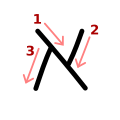
Alef
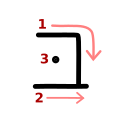
Bet
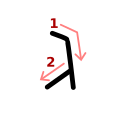
Gimel
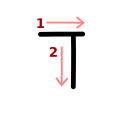
Dalet
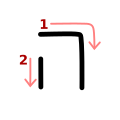
He
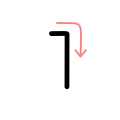
Vav
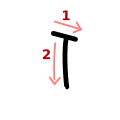
Zayin
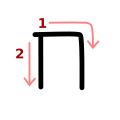
Het
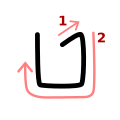
Tet
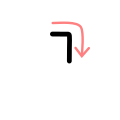
Yod
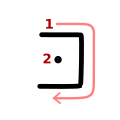
Kaf
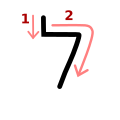
Lamed
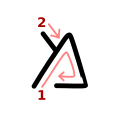
Mem
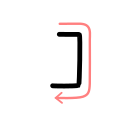
Nun
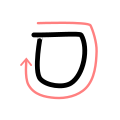
Samekh
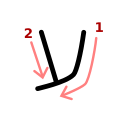
Ayin
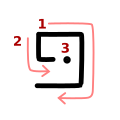
Pe
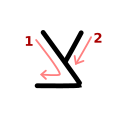
Tsadi
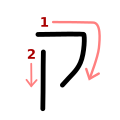
Qof
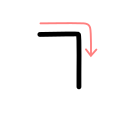
Resh
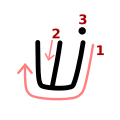
Shin
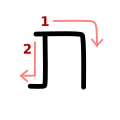
Tav
Stroke order of the final letters
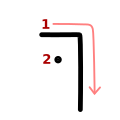
Final Kaf
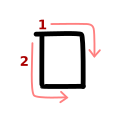
Final Mem
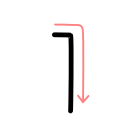
Final Nun
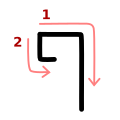
Final Fe
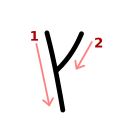
Final Tsadi
Notable variations
Bet/Vet - The horizontal stroke is often written right to left.
Dalet - The two strokes are often combined by going backwards at the end of the first stroke and curving downwards.
Tet - Sometimes written as a single stroke, and sometimes written in reverse.
Lamed - Often written as a single stroke.
Mem - Small stroke written in either direction
Final Mem - Sometimes written as a single stroke
Pe - The second stroke is sometimes written in reverse, or the whole character written as one stroke spiralling outwards.
The block writing sometimes looks a little different from the printed version seen in books.
The most notable difference is probably in the letter Mem, which is squarish in print, but takes on a triangular shape when writing.
